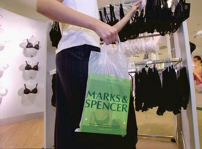Apr 10, 2003April 11, 2003 - Marks & Spencer this week said it will launch a pilot in which it will tag individual apparel items. The company plans to use UHF tags based on the Electronic Product Code technology developed by the Auto-ID Center. One key aim will be to determine whether the technology can improve customer service and increase sales.
The pilot will be run in one store from September to December. If it proves as successful as pilots run by the Gap and other retailers, it could lead Marks & Spencer to eventually tag 350 million apparel items a year.
"The significance of this announcement is really twofold," says Adrian Segens, business development manager for Intellident, the Manchester-based systems integrator that will be installing the technology. "It's the first significant move of RFID into a retail environment, and it's the first the first time EPC is being used to any serious extent in Europe."
Bella Pagdin, a spokesperson for Marks & Spencer, said that the company got £305,000 (US$478,846) from the UK's Department of Trade & Industry (DTI) to launch the pilot. The details of the project are still being worked out, but Marks & Spencer will be looking at automating the process of receiving goods, both shirts and other apparel in boxes and suits on racks.
The company will also test handheld scanners in the store, and then perhaps move to point-of-sale applications over time. "The real business driver for M&S is to free up store staff so they can be serving customers, rather than being involved constantly in stock-taking operations," says Segens.
Intellident tagged 3.5 million reusable trays and dollies in Marks & Spencer's supply chain last year. That successful project used high-frequency (13.56 MHz) tags. This time, Marks & Spencer has chosen to deploy UHF tags, specifically those based on the Auto-ID Center's EPC specification.
"The two great virtues of UHF are the read distance and anti-collision capabilities," says Intellident's Segens. "With high-frequency tags, we are realistically looking at a read range of less than a meter. We want to be able to read from more relaxed distances and be able to read multiple tags in stores. And the other benefit of UHF is its ability to handle many tags in close proximity to one another."
Segens says that 13.56 MHz would work fine for scanning suits hanging on a rack, but if the tags were on lady's lingerie (a high-value, oft-stolen item), the collision between the 13.56 MHz tags would prevent accurate reads. "That's not an issue with UHF tags, which is the reason we've definitely decided to use it," Segens says.
Intellident will evaluate UHF tags from a number of vendors, but Marks & Spencer is intent on using EPC technology because it is low-cost and because there is a limited amount of data on the tag. The retailer can associate information in a database with the serial numbers on the tag, providing greater flexibility.
The announcement came only days after another European retailer, Benetton, issued a press release saying it is not committed to putting RFID tags in clothes. The move was in response to negative press drummed up by privacy advocates after Benetton announced plans to tag is Sisley line of clothing. Marks & Spencer has not formulated a formal privacy plan but will address the issue.
"This is very much about further improving our customer service, so it must be something that our customers are comfortable with," says Marks & Spencer's Pagdin. "We will be looking into the issue during the development of the trial and during the trial itself."


